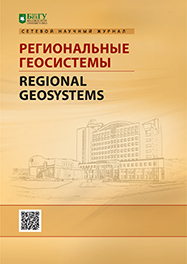The functioning of long-river landscapes in the basin of lake Baikal at intensive anthropogenic load
the work was funded by RFBR according to the research projects № 17-29-05064-ofi_m, №20-55-53030 NSFC_а.
DOI:
https://doi.org/10.18413/2712-7443-2020-44-1-75-84Keywords:
Baikal lake, river basin, valley complexes, history of nature management, anthropogenic transformation, environmental conditionsAbstract
Nature management is main criterion for the formation of the natural environment under the conditions of an increasing anthropogenic pressure on landscapes. The features of the modern functioning of the valley landscapes of the Baikal coastal territories are considered. The identification of the landscape-ecological state of the valley complexes of the rivers flowing into the lake Baikal is the main goal of the work. The analysis of anthropogenic transformation of the landscapes of the Goloustnaya river basin is carried out. Based on a retrospective analysis of the economic development of the territory, three main stages of nature management are identified. It differs in the types of production activities and the intensity of the pressure on the landscape. Modern subtaiga light coniferous and piedmont steppe landscape complexes of the lower reaches of the river, adjacent to the water area of Lake Baikal, are most susceptible to recreational and agricultural activities. The implementation of this activity has led to adverse environmental conditions. The reasons are a decrease in natural species biodiversity (up to the threat of the complete destruction of unique nature objects), the organization of unauthorized landfills, complicated by the lack of measures for the treatment of solid household waste, environmental pollution by livestock waste, the lack of a system for the removal and treatment of surface runoff, and careless handling fire at risk of fires. In this situation, it is necessary to carry out measures to increase the stability of the landscape of river valleys to anthropogenic impacts.
Downloads
References
Большое Голоустное с давних времен до наших дней. URL: http://www.web.archive.org /web/20121015041509/http://goloustnoe.ru/ (дата обращения: 22 августа 2018).
«Ворота Байкала» сократили в размере. Электронный ресурс. URL: http:// www.m.activatica.org/blogs/view/id/2691/title/vorota-baykala-sokratili-v-razmere (дата обращения: 10 ноября 2019).
Голоустненское муниципальное образование. Электронный ресурс. URL: http://www.goloustnenskoe-mo.ru/sotsialnyie_programmyi (дата обращения: 29 октября 2019).
Научно-прикладной справочник по климату СССР. Серия 3. Многолетние данные. Ча-сти 1–6. Выпуск 22. Иркутская область и западная часть Бурятской АССР. Ленинград, Гидроме-теоиздат, 1991.
Село Большое Голоустное. Часть 2. Электронный ресурс. URL: http://www.web. archive.org/web/20130904032851/http://goloustnoe.ru:80/bolshoe2.html (дата обращения: 22 августа 2018).
Федеральные целевые программы России. Электронный ресурс. URL: https://www.fcp. economy.gov.ru/cgi-bin/cis/fcp.cgi/Fcp/ViewFcp/View/2017/359/ (дата обращения: 11 ноября 2019).
Об охране озера Байкал: федеральный закон от 01.05.1999 г. № 94-ФЗ (в редакции от 22.08.2004 г. № 122-ФЗ) // СПС КонсультантПлюс. URL: http http://www.consultant.ru /document/cons_doc_LAW_22964/ (дата обращения: 20 сентября 2019).
Экологически ориентированное планирование землепользования в Байкальском реги-оне. Бассейн р. Голоустной. Иркутск – Ганновер, 1997.
Абалаков А.Д., Кузьмин В.А., Снытко В.А. 1990. Природная специфика Голоустенского побережья Байкала. География и природные ресурсы, 4: 51–61.
Воробьева И.Б., Власова Н.В. 2018. Качество поверхностных и подземных вод населенных пунктов Юго-Западного побережья оз. Байкал. Природа Внутренней Азии, 3 (8): 38–50.
Гагаринова О.В., Белозерцева И.А., Воробьева И.Б., Власова Н.В., Янчук М.С., Лопатина Д.Н. 2018. Степень трансформации устьевых областей притоков оз. Байкал. Природа Внутренней Азии, 4 (9): 15–26.
Кравцова В.И., Михайлов В.Н. 2017. Антропогенные изменения геосистем современной дельты Хуанхэ. Вестник Московского Университета. География, 2: 33–42.
Кузьмин В.А. 1998. Экология, география и свойства почв бассейна р. Голоустной в Прибайкалье. Сибирский экологический журнал, 6 (V): 571–579.
Патканов С. 1906. Опыт географии и статистики тунгусских племен Сибири на основании данных переписи населения 1897 г. и др. источников. Тунгусы собственно. Записки Императорского русского географического общества по отделению этнографии, 31 (I-1): 246 с.
Патканов С. 1912. Статистические данные, показывающие племенной состав населения Сибири, язык и роды инородцев (на основании данных специальной разработки материала переписи 1897 г.). Иркутская губ., Забайкальская, Амурская, Якутская, Приморская обл. и о. Сахалин. Записки Императорского русского географического общества по отделению статистики, 11 (3): 378 с.
Рябцев В.В., Турута А.Е. 2003. Сохранение биоразнообразия Байкальских степей: опыт Прибайкальского национального парка. Электронный ресурс. URL: http://www.orenpriroda.ru/ steppene/sim2003 (дата обращения: 10 ноября 2019).
Семенов П.П., Черский И.Д., Петц Г.Г. 1895. Землеведение Азии Карла Риттера. География стран, входящих в состав Азиатской России или пограничных с нею. Восточная Сибирь, озеро Байкал и Прибайкальские страны, Забайкалье и степь Гоби. Часть II. Санкт-Петербург, 630 с.
Aktasa S., Ylmazb A., Othmanc N. 2019. Views on the effects of nature-based tourism activities on the environment: the case of Fairy Chimneys tourism region (Turkey). Journal of tourism, leisure and hospitality, 1 (1): 35–42.
Krul V., Holyavchuk D. 2014. Landscape recreational resources assessment. current situation and prospects (on the example of river-valley landscapes). Journal of settlements and spatial planning, 5 (1): 61–66.
Rojas-Caldelas R., Leyva-Camacho O., Pena-Salmon C., Corona-Zambrano E., Arias-Vallejo A. 2014. Qualitative assessment of the Mexicali valley landscape: residents and non-residents. The sustainable city 9 (1): 141–150.
Sender J., Maslanko W. 2018. Natural values of the urban river valley and the possibilities of its development – Bystrzyca river valley study case (Poland). Transylvanian review of systematical and ecological research, 20 (2): 85–102.
Abstract views: 377
Share
Published
How to Cite
Issue
Section
Copyright (c) 2020 REGIONAL GEOSYSTEMS

This work is licensed under a Creative Commons Attribution 4.0 International License.


